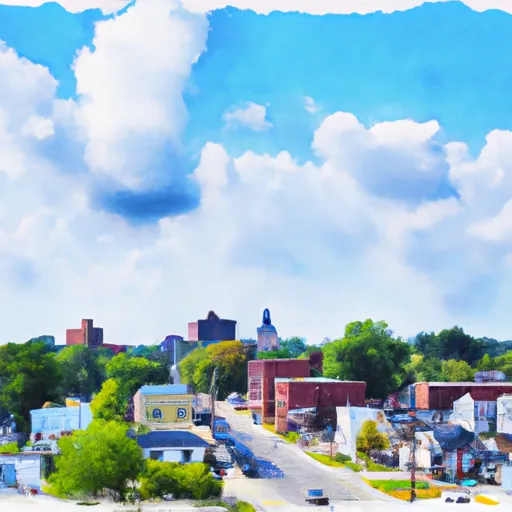-
 Snoflo Premium
Snoflo Premium
Get unlimited access to all our content
With no Ad interruptions! - Start Your Free Trial Login with existing account
Monticello
Eden Index
Climate
7.9
•
Recreation
1.2
•
Community
2.5
•
Safeguard
4.2/10

Monticello, Indiana is a charming town located in White County, in the north-central part of the state. The climate in Monticello is considered humid continental, characterized by hot summers and cold winters. Average temperatures range from 20°F (-7°C) in winter to 85°F (29°C) in summer, offering a diverse climate for residents and tourists alike.
Monticello is surrounded by several lakes, including Lake Shafer, Lake Freeman, and the Tippecanoe River. These hydrological constituents provide ample opportunities for water-based activities such as fishing, boating, swimming, and water skiing. Lake Shafer and Lake Freeman are particularly popular for their beautiful shorelines, sandy beaches, and stunning sunsets.
Outdoor recreation enthusiasts will find plenty to enjoy in Monticello. The area offers various parks, trails, and campgrounds, ideal for hiking, biking, picnicking, and camping. For those interested in wildlife observation, the region is home to diverse species, including waterfowl, migratory birds, and deer.
Monticello's climate, hydrology constituents, and outdoor recreation opportunities make it an attractive destination for nature lovers and adventure seekers throughout the year.
What is the Eden Index?
The Snoflo Eden Index serves as a comprehensive rating system for regions, evaluating their desirability through a holistic assessment of climate health, outdoor recreation opportunities, and natural disaster risk, acknowledging the profound impact of these factors on livability and well-being.
Climate Health Indicator (CHI): 7.9
Monticello receives approximately
998mm of rain per year,
with humidity levels near 81%
and air temperatures averaging around
11°C.
Monticello has a plant hardyness factor of
5, meaning
plants and agriculture in this region thrive during a short period during spring and early summer. Most
plants will die off during the colder winter months.
By considering the ideal temperature range, reliable water supplies, clean air, and stable seasonal rain or snowpacks, the Climate Health Indicator (CHI) underscores the significance of a healthy climate as the foundation for quality living.
A healthy climate is paramount for ensuring a high quality of life and livability in a region, fostering both physical well-being and environmental harmony. This can be characterized by ideal temperatures, reliable access to water supplies, clean air, and consistent seasonal rain or snowpacks.
Weather Forecast
Streamflow Conditions
Wabash
Area Rivers
Wabash
Snowpack Depths
Wabash
Reservoir Storage Capacity
Wabash
Groundwater Levels
Recreational Opportunity Index (ROI): 1.2
The Recreational Opportunity Index (ROI) recognizes the value of outdoor recreational options, such as parks, hiking trails, camping sites, and fishing spots, while acknowledging that climate plays a pivotal role in ensuring the comfort and consistency of these experiences.
Access to outdoor recreational opportunities, encompassing activities such as parks, hiking, camping, and fishing, is crucial for overall well-being, and the climate plays a pivotal role in enabling and enhancing these experiences, ensuring that individuals can engage in nature-based activities comfortably and consistently.
Camping Areas
| Campground | Campsites | Reservations | Toilets | Showers | Elevation |
|---|---|---|---|---|---|
| West Boggs Park | 220 | 528 ft | |||
| Dubois County Park | 32 | 575 ft | |||
| Saddle Lake Rec Area | 13 | 589 ft | |||
| Ferdinand State Forest | 70 | 489 ft | |||
| Crane MWR Military | None | 594 ft | |||
| Tipsaw | 50 | 576 ft | |||
| Springs Valley Rec Area | 10 | 672 ft | |||
| Newton Stewart State Rec Area - Patoka Lake | 500 | 728 ft | |||
| Celina Recreation Area | 55 | 709 ft | |||
| Martin State Forest | 25 | 743 ft |
Nearby Ski Areas
Catastrophe Safeguard Index (CSI):
The Catastrophe Safeguard Index (CSI) recognizes that natural disaster risk, encompassing floods, fires, hurricanes, and tornadoes, can drastically affect safety and the overall appeal of an area.
The level of natural disaster risk in a region significantly affects safety and the overall livability, with climate change amplifying these risks by potentially increasing the frequency and intensity of events like floods, fires, hurricanes, and tornadoes, thereby posing substantial challenges to community resilience and well-being.
Community Resilience Indicator (CRI): 2.5
The Community Resilience Indicator (CRI) recognizes that education, healthcare, and socioeconomics are crucial to the well-being of a region. The CRI acknowledges the profound impact of these elements on residents' overall quality of life. By evaluating educational resources, healthcare accessibility, and economic inclusivity, the index captures the essential aspects that contribute to a thriving community, fostering resident satisfaction, equity, and social cohesion.

